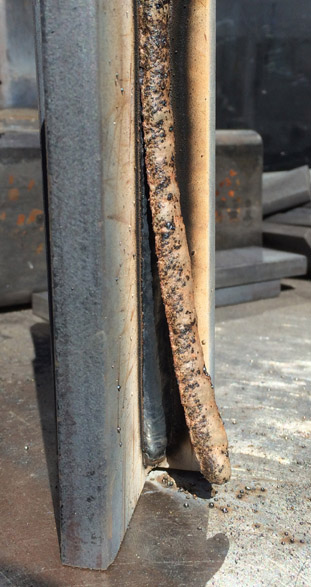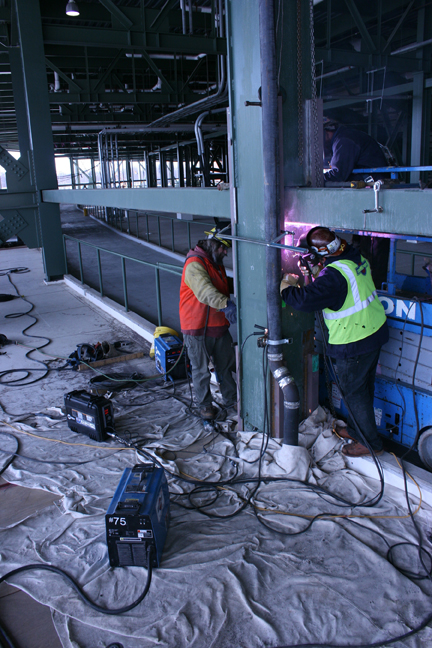Self-Shielded Flux Core Wire: Why and How to Use It for Your Weld Job
In an increasingly competitive environment, some contractors in the structural steel industry are converting from stick welding (SMAW) to self-shielded flux-cored welding (FCAW) as one way to improve productivity and to reduce costs. Stick welding has traditionally been the process used on jobsites for major infrastructure jobs, as it is a familiar process to many welding operators, it offers mobility since shielding gas cylinders and a wire feeder are not required.
In recent years, significant technology advancements in both equipment and filler metals have made the self-shielded FCAW process a more viable option for contractors — one that offers higher productivity, and can save time and money in labor. Self-shielded FCAW wires are now formulated to be easier to use and to provide better weld quality than ever before, making them more appealing to many contractors. While self-shielded FCAW is a faster process that can offer a competitive edge, to get the best results it is important to understand the characteristics of the most commonly used wires for construction applications, as well as proper welding techniques, in order to get the best results.
Common wire classifications
Technology advancements have resulted in self-shielded FCAW wires with improved mechanical properties and welding performance, including better weld pool and arc control, on top of the productivity gains provided by this continuous welding process.
The two most common types of self-shielded flux-cored wires used by contractors for welding in construction applications are those meeting American Welding Society (AWS) E71T-11 and AWS E71T-8 classifications. These wires — also known as T-11 and T-8 — are versatile options for structural applications, and are both suited for all-position, general purpose welding.
Choosing the proper equipment when using either type of wire is key. Both the T-8 and T-11 wires should be used with a constant voltage (CV) power source, rather than a constant current (CC) power source. The power received from a CC power source fluctuates too much when using these wires, and can cause inconsistent quality and weld defects such as porosity. Conversely, a CV power source provides the constant voltage needed for smooth arc performance and is particularly adept at adjusting for “dirty power” on jobsites — high and low spikes in power generated when multiple loads (like compressors and power sources) are on the same line.
T-8 and T-11 wires should both be operated on DCEN (direct current electrode negative) or straight polarity, which is opposite of most wire filler metals. It is important to note that using the incorrect polarity can result in poor welding performance, including increased spatter levels. In addition to these equipment considerations, suitcase wire feeders — rugged suitcase-like feeders that encase and protect the wire — are often used with these wires to improve portability on the jobsite.
Characteristics of T-11 wires
Wires classified as AWS E71T-11 are generally considered easy-to-use and provide a wide parameter window that is forgiving to technique errors, which is particularly helpful for welding operators who are newer to the self-shielded FCAW process.
Contractors should keep in mind that T-11 wires offer no toughness properties, (and they are not required to in order to meet the AWS E71T-11 classification) so they are not as resistant to cracking as something like a T-8 product. As a result these wires are not used for critical welding, however AWS D1.1 Structural Welding Code for Steel does allow the use of T-11 wires for welding on materials less than 1/2 inch thick. They are most commonly used on a construction site for small stitch welds or tack welds.
The typical parameter range when using T-11 wires is between 17 to 22 volts and 50 to 275 amps, depending on wire diameter. If the application allows, using larger wire diameters can provide greater deposition rates for improved productivity. Filler metal manufacturers generally offer these wires in 0.035-inch diameters all the way up to 5/64-inch diameters. During the welding process, T-11 wires require a technique similar to the one used for gas-shielded FCAW wires. A 1/2- to 3/4-inch stickout (again depending on wire diameter) and 10 to 20 degree drag angle will help minimize the risk of slag inclusions and offer the best joint penetration.

weld as an example, shows a high quality
weld made with a T-8 wire and the protective
slag self-releasing from it.
Characteristics of T-8 wires
In contrast to T-11 wires, T-8 wires offer very good toughness with no thickness restrictions. Wires under the AWS E71T-8 classification must meet a toughness requirement of 20 foot-pounds at -20 degrees Fahrenheit. For the classification E71T-8 J, the additional “J” designator indicates that the wire offers increased toughness properties of 20 foot pounds at -40 degrees Fahrenheit, for lower temperature impact strengths.
T-8 wires are often approved for Demand Critical Welds like those that must follow requirements of AWS D1.8/D1.8M Structural Welding Code – Seismic Supplement. There are two different ways to qualify filler metals to be used for seismic applications under AWSD1.8: qualified to the “D” designator or qualified to Annex A. If a filler metal is qualified using the “D” designator there is a “D” included in the AWS classification, as in the example E71T-8JD H8. When a wire is qualified to Annex A, it can be used for D1.8 applications, but there is simply no “D” designator in the AWS classification. Annex A allows for more deviation from set parameters for the testing that filler metal manufacturers must complete, but wire qualified to this standard is still approved for use under AWS D1.8. Contractors can feel certain that both classifications of wires will provide the appropriate mechanical and chemical properties, specifically toughness, for the job.
T-8 wires can be more difficult to use than T-11 wires and are less forgiving to technique errors. The T-8 wires produce a very heavy slag that can interfere with the welding arc, which can prevent the weld bead from wetting out properly.
Following a drag technique with the appropriate travel speeds to tie in the weld at the toes is important. For the best results when welding with T-8 wires, the stickout should be longer than with T-11 wires — 1 inch to 1-1/4 inch — depending on wire diameter. The general rule is that a larger diameter wire will require a longer stickout. Contractors should note, however, that the smallest available diameter of T-8 wires usually available is 1/16-inch. This is because T-8 wires have a higher fill percentage (the percentage of the wire cross section that is powder), making it more difficult for manufactures to draw the wire down to a smaller size.
The recommended parameter range for T-8 wires is 18 to 23 volts and 200 to 275amps for all-position welding for the range of available diameters.
Storage requirements
As with any filler metals, it is imperative to prevent against moisture pickup when using either T-8 or T-11 wires. With self-shielded FCAW wires like these, moisture can potentially lead to worm tracking in the weld bead, which is a discontinuity similar to porosity. It forms under the slag on top of the weld bead. Properly storing filler metal packages in a dry, enclosed environment — while keeping the wire in its original packaging — can help prevent moisture pick-up. Ideally, the storage temperature should be between 40 degrees and 120 degrees Fahrenheit, with a maximum humidity of 80 percent.
Realize advantages with proper training
To get the best results from self-shielded FCAW wires and to meet the appropriate welding code(s), welding operator training and proper certification is essential. It’s also important to have a solid understanding of the characteristics and operating requirements of the T-8 or T-11 wires being used in order to weld successfully with them.By taking the proper steps and precautions, contractors can realize many productivity advantages from these wires and ensure that quality requirements of critical structural applications continue to be met.
Related Articles:
Flux-Cored Wires for Welding High-Temperature and High-Strength Applications



